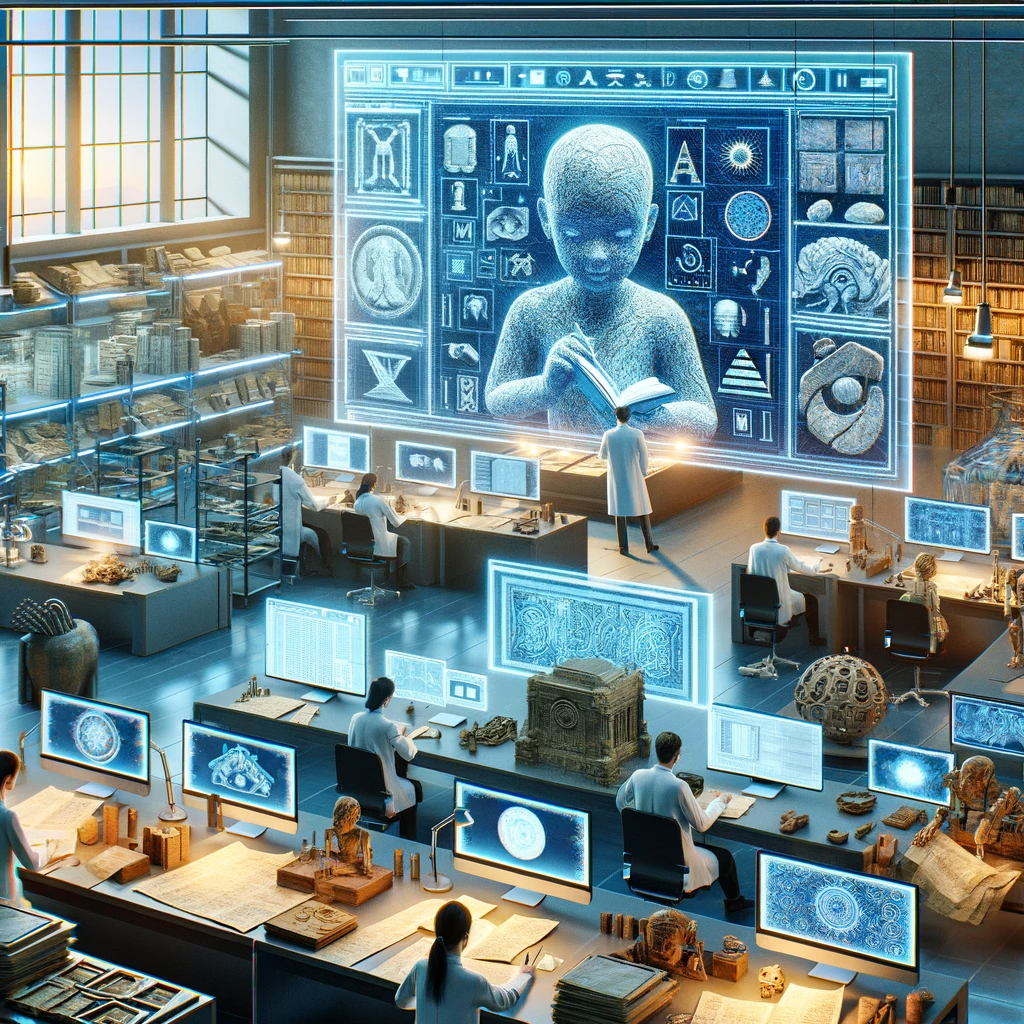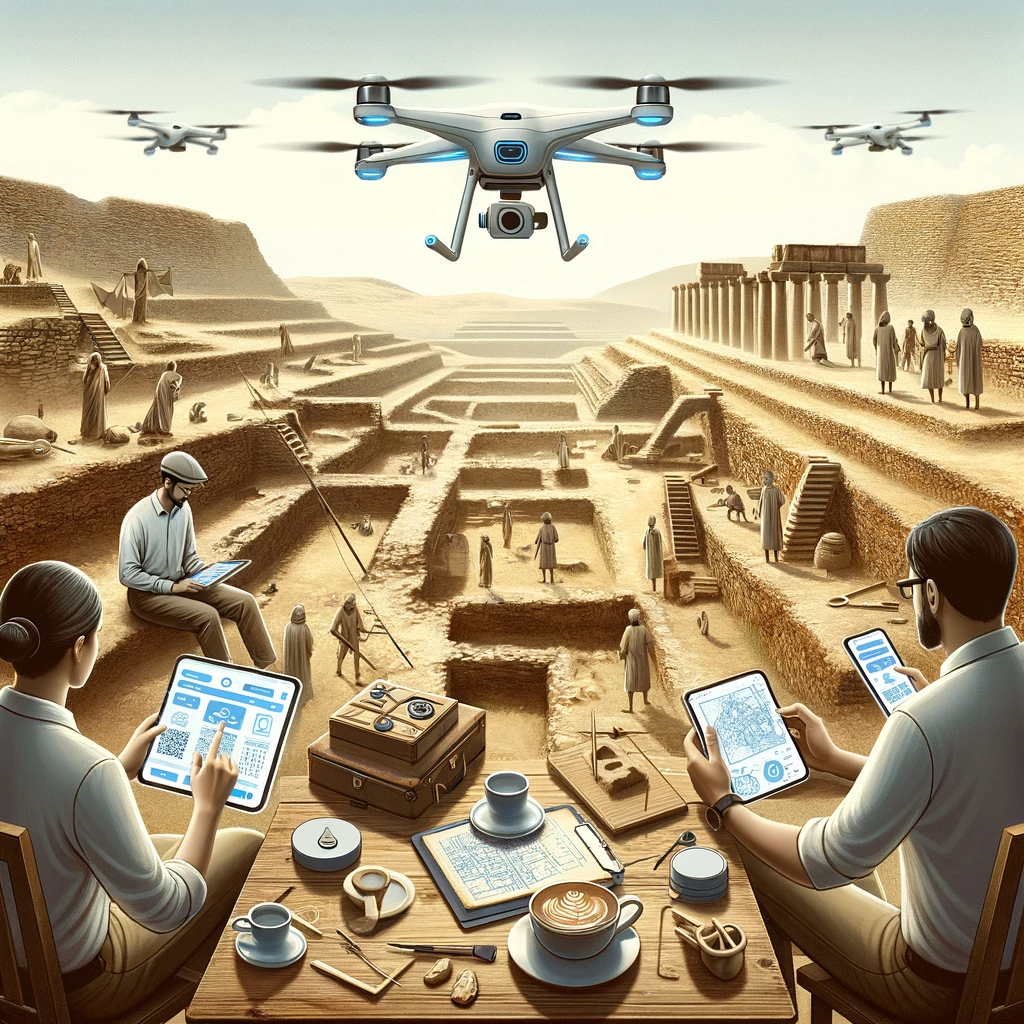The sands of time conceal the stories of our ancestors, and buried beneath layers of history lie the secrets of civilizations long past. Archaeology and historical research serve as the keys to unlock these mysteries, shedding light on the tapestry of human existence. However, the traditional methods of unearthing and deciphering our history are labor-intensive, time-consuming, and sometimes limited in scope. In this era of technological advancement, a new ally has emerged to revolutionize the way we delve into the past—Artificial Intelligence (AI).
This article embarks on a captivating journey through time to explore the profound impact of AI on the fields of archaeology and historical research. It seeks to answer a pivotal question: Is AI redefining the way we discover and interpret history? As we navigate the landscapes of the past and the possibilities of the future, we witness AI’s transformational role in uncovering and understanding our shared heritage.
Archaeology, the study of past human cultures through the analysis of artifacts, sites, and historical contexts, plays a vital role in piecing together the puzzle of human history. Similarly, historical research, which delves into documents and records to understand historical events, societies, and cultures, contributes to our understanding of the past’s profound influence on the present.
Traditional approaches in these fields have relied on manual excavation, document analysis, and painstaking historical research. While these methods have yielded invaluable insights, they are not without limitations. They often require significant time and effort, and there is always the risk of missing critical details hidden beneath the earth’s surface or within ancient manuscripts.
The need for more advanced techniques and approaches in archaeology and historical research has led to the emergence of AI. In this article, we delve into AI’s entry into the realm of archaeology. We explore how AI-driven algorithms analyze satellite imagery and geographical data to identify potential archaeological sites, leading to remarkable discoveries. Additionally, we examine how AI is revolutionizing the analysis of artifacts, from deciphering ancient scripts to shedding light on enigmatic relics.
Beyond site discovery and artifact analysis, AI extends its reach into understanding historical contexts. It has the ability to analyze historical texts, manuscripts, and documents, making sense of vast archives and offering new perspectives on ancient writings. AI also plays a pivotal role in reconstructing historical buildings, cities, and landscapes, allowing us to walk in the footsteps of our ancestors.
However, the integration of AI into archaeology and historical research raises ethical considerations. The preservation of cultural heritage, data privacy, and responsible AI use are essential aspects of this discussion. It is crucial to recognize that AI is a tool for researchers, not a replacement, emphasizing the importance of collaboration between AI experts and historians/archaeologists in interpreting AI-generated insights.
As we peer into the future, we contemplate the potential advancements in AI technology that could further transform these fields. Predictive models for archaeological site discoveries and interdisciplinary collaborations promise to expand the horizons of understanding our shared history.
This article serves as a gateway to a world where AI and history converge. It celebrates the transformative potential of AI in archaeology and historical research, providing a glimpse into a future where the past is unveiled with unprecedented clarity. As we embrace AI as a valuable tool in uncovering and preserving our rich historical heritage, we embark on a journey that transcends time and connects us with the legacies of those who came before us.

AI’s Entry into Archaeology:
Archaeology, a field deeply rooted in the physical world, has experienced a significant transformation with the integration of AI. This section explores AI’s groundbreaking contributions to archaeological research.
AI in Site Discovery: AI has ventured into the realm of site discovery, aiding archaeologists in the identification of potential archaeological sites with remarkable precision. By harnessing AI-driven algorithms, researchers can analyze satellite imagery, geographical data, and environmental factors to pinpoint locations where historical treasures may lie concealed. Through AI’s virtual eyes in the sky, ancient civilizations and forgotten cities are being rediscovered, reshaping our understanding of the past.
Artifact Analysis with AI: Delving further, AI is at the forefront of artifact analysis, breathing new life into the study of ancient objects. Whether it’s pottery fragments, inscriptions, or cryptic relics, AI algorithms excel in deciphering and interpreting these enigmatic artifacts. By employing machine learning and image recognition, AI enhances the accuracy and efficiency of artifact analysis, revealing stories that were once hidden within the intricate details of ancient objects.
Understanding Historical Contexts with AI:
Beyond physical discoveries, AI extends its reach into the realm of historical research, offering insights into the contexts in which historical events unfolded. This section explores how AI is unraveling the mysteries of the past by decoding ancient texts and reconstructing historical landscapes.
AI in Textual Analysis: The study of history often relies on the interpretation of historical texts, manuscripts, and documents. AI-driven textual analysis tools are making this task more manageable than ever before. By applying natural language processing and machine learning algorithms, AI can process vast archives of historical documents, identifying trends, connections, and insights that human researchers might overlook. With AI’s assistance, ancient writings are becoming more accessible and comprehensible, shedding light on historical narratives that have eluded us for centuries.
AI’s Role in Reconstruction: For historians and archaeologists, reconstructing the physical aspects of history, such as ancient buildings, cities, and landscapes, is a formidable challenge. AI steps in as a digital architect, employing algorithms and historical data to reconstruct these elements virtually. Through AI-driven reconstructions, we can walk through the streets of ancient Rome, explore lost civilizations, and witness historical events in immersive detail. AI’s role in breathing life into the past extends our ability to comprehend the historical contexts in which our ancestors lived.
The Ethical and Interpretive Aspects of AI in History:
The introduction of AI into archaeology and historical research comes with a set of ethical considerations and interpretive nuances. This section navigates the complex terrain of ethics and interpretation in AI-enhanced historical investigations.
Ethical Considerations: AI’s involvement in the study of history raises ethical concerns related to data privacy, cultural sensitivity, and responsible AI use. Preserving cultural heritage and respecting the communities linked to archaeological sites are vital considerations. This section addresses the ethical challenges and emphasizes the need for ethical guidelines to govern AI’s role in preserving history.
Interpretation and Collaboration: AI is a tool that augments the capabilities of human researchers but does not replace them. Collaboration between AI experts and historians/archaeologists is crucial to ensure the accurate interpretation of AI-generated insights. This section underscores the importance of interdisciplinary cooperation to extract the full potential of AI in historical research.
The Future of AI in Archaeology and Historical Research:
As we look ahead, the potential of AI in archaeology and historical research appears boundless. This section explores the future horizons of AI’s transformative role in understanding our shared history.
Advancements in AI Technology: The field of AI is continuously evolving, and technological advancements promise even more profound transformations in archaeology and historical research. Predictive models for archaeological site discoveries, enhanced artifact analysis techniques, and ever-smarter textual analysis algorithms hint at a future where the past is unveiled with unprecedented precision.
Expanding Horizons: AI’s impact transcends the boundaries of individual disciplines. Interdisciplinary collaborations are expected to flourish, allowing experts from diverse fields to harness AI’s power in innovative ways. As we embrace AI as an indispensable tool, we embark on a journey that transcends time, connecting us with the legacies of those who came before us.

In conclusion, the integration of AI into archaeology and historical research is ushering in a renaissance of discovery and understanding. AI is reshaping how we explore the physical remnants of the past, decode ancient writings, and reconstruct historical landscapes. Yet, this transformation is not without its ethical considerations and the need for collaborative interpretation.
As we gaze into the future, we are met with the promise of even greater advancements in AI technology and the potential for deeper interdisciplinary connections. With AI as our ally, we embark on a journey that transcends time, connecting us with the legacies of those who came before us. The story of humanity is being retold with newfound clarity, and the pages of history are turning more effortlessly, thanks to the transformative power of AI.
